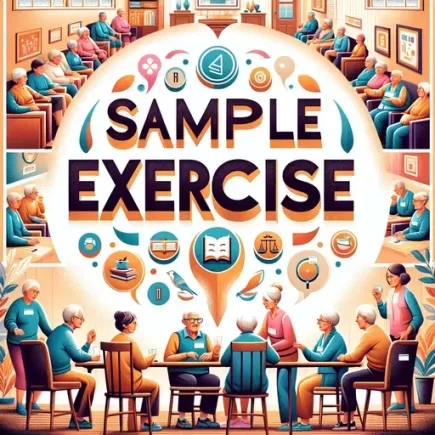This is a sample lesson from the book Memory Chit Chat: Communication Exercises for Cognitive Stimulation by Barbara Van Dyne, M.A speech-language pathologist. If you find this lesson useful, consider purchasing the full book, which has 52 more lessons just like it. It is available on Amazon:
Food, Glorious Food!
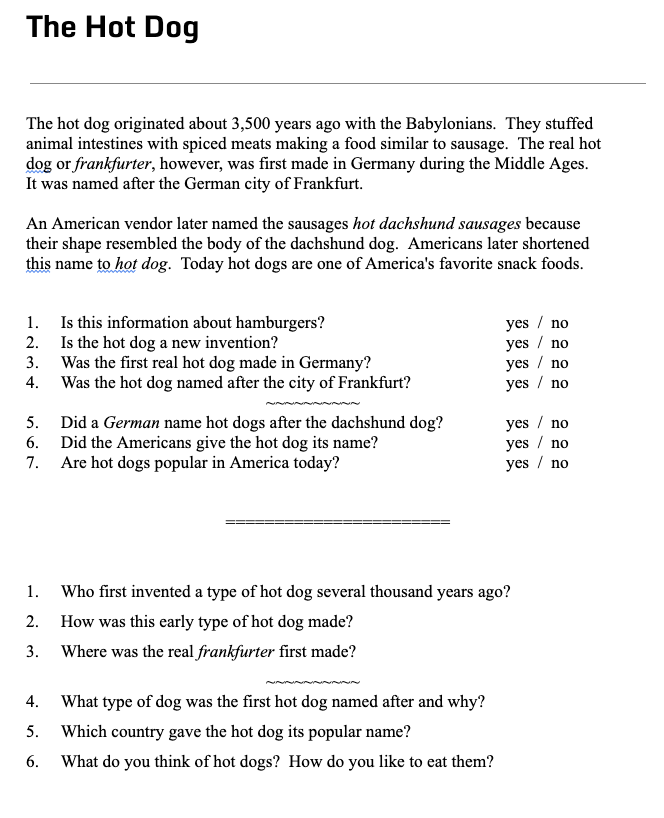

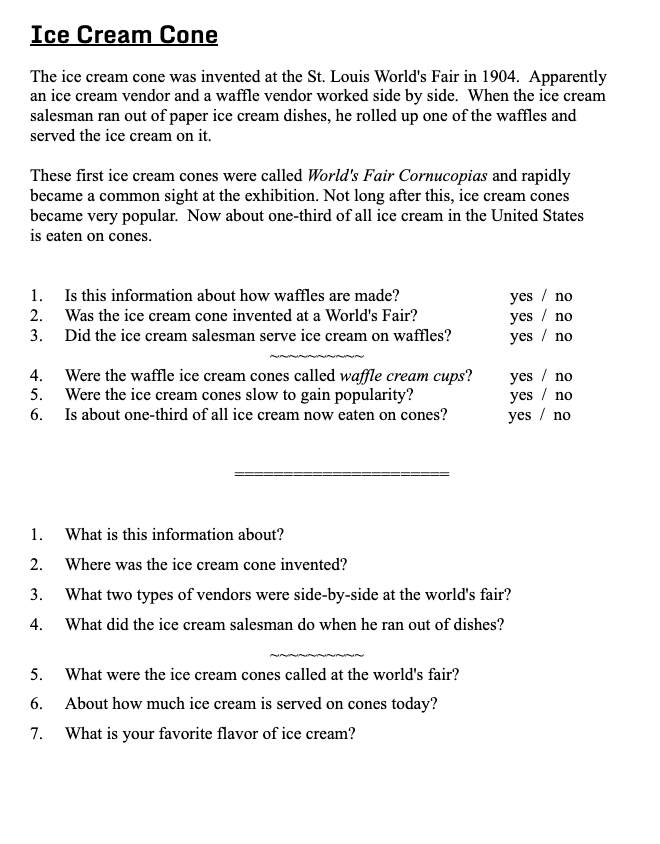
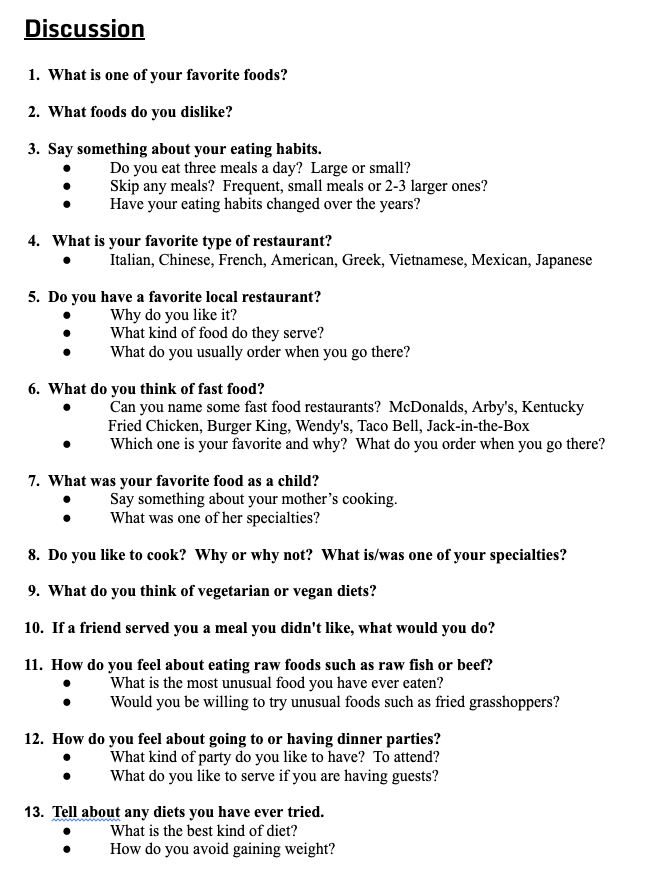
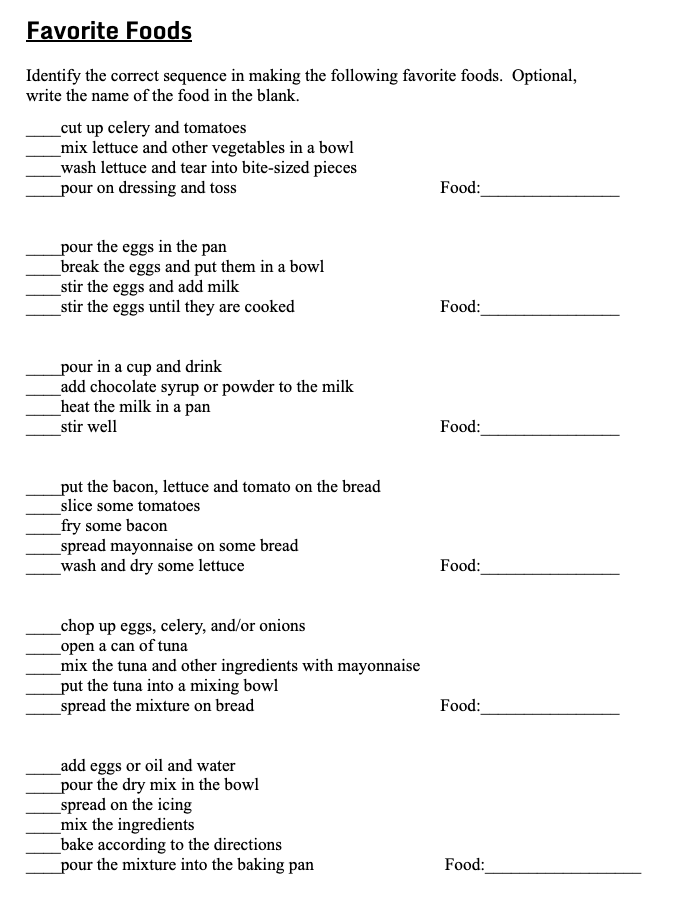
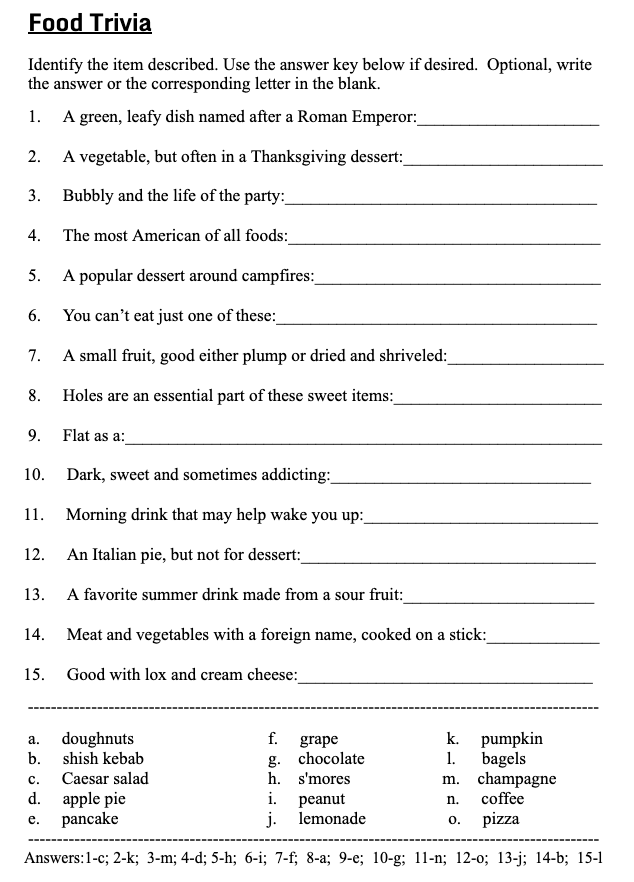
How To Use This Lesson
This exercise contains thematic units that correspond to timely social and historical events. Units contain the following tasks:
- Paragraph comprehension and memory
- Yes/No questions
- Open-ended questions
- Discussion questions
- Opinions
- Feelings
- Reminiscing / long term memory
- Cognitive, verbalization and word-finding activities such as:
- Trivia questions
- Guessing games
- Categorization tasks
- Sequencing tasks
Using the Materials
Paragraphs, categorization, sequencing, trivia and other vocabulary tasks:
These were designed to stimulate reading and/or auditory comprehension, memory, oral reading, yes/no reliability, word-finding, verbal expression, writing, and speech intelligibility. Vary the manner of presentation depending on the goals and abilities of the participant(s).
Auditory comprehension and memory / verbal stimulation
- Read the stimuli to the participant(s) and request verbal responses to the questions.
- The paragraph pages contain two paragraphs with questions relating to each one. Present both paragraphs and all questions for higher level clients. To make the task easier, present one paragraph at a time, followed by the questions that pertain to that paragraph.
- Cue less verbal clients with either/or questions and give other hints as needed.
- Consider asking higher level clients to paraphrase the paragraphs.
Reading comprehension and memory / verbal stimulation
- Have the participants silently read the paragraphs, questions, or tasks and answer the questions verbally or in writing.
- Trivia worksheets contain an answer key at the bottom or on the side.
- Conceal the answers to make the task more difficult, or allow the clients to select from the answers when cues are needed.
Writing
- Request written answers to any of the questions.
Speech intelligibility
- Request oral reading of any of the stimulus materials.
Nonverbal communication
- Encourage pointing, gesturing, drawing, facial expression, etc.
Guessing Game
The Guessing Game activities were designed to elicit functional verbal or nonverbal communication. Encourage pointing, gesturing, drawing, writing, facial expression, etc. Suggested guidelines:
- Write the keywords on note cards.
- Provide pictures, if available, for those who cannot read.
- Review the note cards or pictures before you start the game.
- Place the cards or pictures face down on the table.
- Take turns selecting the cards and conveying what the item is.
- Encourage participant(s) to ask relevant questions:
Why doesn’t someone ask Bill what color it is? how big it is? what it is used for? Or
Why don’t you ask me what we do with it? etc.
- To make the task easier, provide a duplicate set of cards so that the clients may refer to them if needed.
- In a group, consider dividing into teams.
Discussion Questions
The discussion questions were designed to stimulate verbal expression, speech intelligibility, word-finding, nonverbal communication, problem-solving, abstract thinking, reminiscing, expression of opinions and pragmatic aspects of communication such as turn taking, eye contact, reducing excessive verbalization and acknowledging another’s perspective. The goal for these questions may be functional communication rather than linguistic perfection.
Some of the questions purposely refer to controversial and sensitive topics. These subjects can facilitate dynamic communication, but discretion is advised. Ask those questions that are appropriate for your clients.
The following procedure may be implemented if appropriate, depending on abilities of the participant(s):
- Write the questions on note cards to provide a visual stimulus.
- Take turns asking and answering the questions to stimulate conversation.
- Encourage all modes of communication.
- To facilitate interaction among members of a group, after each member has answered a question, have them ask the others the question.
Timing of the Units
Most of the units were ordered to coincide with events occurring during the year. However, certain holidays do not occur consistently during the same week or month. For example, Chinese New Year, Easter and Passover vary between adjacent months. The Getting to Know You chapter would be most effective at the onset of a program or relationship. Adjust the order of presentation according to the occurrence of the events for the current calendar year.
General Guidelines
Optional, inform the participant(s) of the next week’s topic and invite them to bring pictures, memorabilia, articles or items of interest that relate to that topic. Supplement the units with media materials related to the themes such as pictures, newspaper and magazine articles, advertisements, cartoons, photographic books, recipes, menus, junk mail and video clips. Modify the materials to fit the needs, background and experience of your clients. Expand the tasks with spontaneous discussion. Use fundamental cueing strategies such as either/or and yes/no questions, phoneme or grapheme cues and phrase completions as needed. Encourage non-verbal clients to use pointing, gestures, drawing, facial expressions and pantomime.
Conclusion
These materials have been developed during my decades long active speech therapy practice. Occasionally there is someone who is not interested in a certain topic, but most of the material appears to stimulate and elicit meaningful communication as well as both long term and short term memory. In group work, the familiarity and shared experiences inherent in the themes help increase interest and facilitate meaningful communication among the group members. After years of using structured, drill-like tasks, I have found that the materials contained in this book, supplemented by media materials, provide a fertile breeding ground for meaningful language and cognitive stimulation.
Start of Sample Lesson
Baseball
Baseball is such a popular American sport that it is called the national pastime. There are organized baseball teams for all ages, from six years old to adulthood. It was once thought that Abner Doubleday invented baseball. Historical evidence, however, indicates that it actually developed from an English sport called rounders. Rounders was similar to modern day baseball except that the fielders threw the ball at the runner to put him out.
The Civil War helped to spread the popularity of baseball. Confederate prisoners learned baseball by watching Union soldiers play. When the Confederate soldiers returned home, baseball became popular throughout the South. In 1869, the Cincinnati Red Stockings decided to pay its players, making the Red Stockings the first professional baseball team. Within a century, baseball developed into a multi-million dollar national pastime.
| Is baseball called the national pastime? | yes / no |
| Did Abner Doubleday invent baseball? | yes / no |
| Did baseball develop from a similar game in France? | yes / no |
| In rounders did the fielders try to hit the runner with the ball? | yes / no |
~~~~~~~~~~
| Did the Civil War help spread the game of baseball? | yes / no |
| Were the Yankees the first professional baseball team? | yes / no |
| Is baseball now a multi-million dollar business? | yes / no |
=======================
| Why is baseball called the national pastime? |
| From what game did baseball develop? |
| In which country was rounders popular? |
| In rounders, what did the fielders have to do to put out a player ? |
~~~~~~~~~~
| How did the Civil War spread the game of baseball? |
| What team was the first to pay its players? |
| How big has the sport of baseball become? |
Discussion
1. What do you think of baseball?
- Why do so many people like baseball?
- Is baseball your favorite sport? If not, what is?
2. Did you or anyone you know ever play baseball?
- Your children, brothers, sisters, grandchildren, spouse
3. What kind of baseball games have you attended?
- Little League, sandlot, professional, farm
- Was there one that was especially memorable?
4. How many professional baseball teams can you name? (see following pages)
- Which one is your favorite? Why?
- Who might play in the World Series this year? Who do you think will win?
5. Can you name any famous professional baseball players?
- Who is your favorite? Why?
- Babe Ruth, Mickey Mantle, Lou Gehrig (had fatal disease), Joe DiMaggio (married Marilyn Monroe), Stan Musial, Jackie Robinson, Willie Mays, Yogi Berra, Pete Rose (expelled for gambling), Barry Bonds, Mark McGuire, Jose Canseco, Roger Clemens, Mariano Rivera
- Encourage discussion about these players. For what team did they play?
6. What do you think of professional baseball salaries?
- Why are they so high?
- What should be done about this, if anything?
- Should players be allowed to strike? Why or why not?
7. Can you name the nine defensive positions?
- Catcher, pitcher, short stop, three baseman (1st, 2nd, 3rd), three fielders (left, right, center). Which position requires more skill and why?
8. If you were going to a baseball game, what would you take with you?
- Money, snacks (what kind?), hat, sun screen, glove (for catching fly balls), binoculars, camera, rain gear, ticket, seat cushion, blanket
- What would you wear? Discuss the time of year and the weather forecast.
9. What are some typical foods or drinks people enjoy at baseball games?
- Popcorn, ice cream, pizza, peanuts, cotton candy, beer, soda, cracker jacks
- Which of these do you prefer?
10. As a child, did you admire any sports figures? Who?
Role Playing Activity
- Ask the participant(s) to pretend they are buying a ticket to a baseball game.
- What information would they need? If needed, write the questions on note cards for visual cues.
- What teams are playing?
- How much do the tickets cost?
- Where are the seats?
- What time does the game start?
- What is the date of the game?
- What is the best way to get to the game?
- How much will parking cost?
- Role-play ordering the tickets to the game.
- Take turns being the fan and the ticket agent.
- Refer to the printed questions as needed.
Baseball Charades or Drawing Activity
- Copy the following page for each participant and provide blank paper.
- Read or have the participant(s) read the list.
Ask them to choose one of the items and draw a picture of it or pantomime it so you or the others can guess what it is.
Take turns choosing and guessing until most items are drawn or enacted.
Guessing Game Activity
- Write the words from the following page on note cards.
- Take turns selecting a card and describing or guessing the item.
Baseball Charades or Drawing
Draw or pantomime the following:
1. Baseball
2. Baseball bat
3. Glove
4. Baseball cap
5. Peanuts
6. Hotdog
7. Home plate
8. Umpire
9. Ice cream cone
10. Ticket
11. Diamond
12. Pennant
13. Beer
14. Soda
15. Cracker jacks
Baseball Trivia
Identify the item described. Use the answer key below if desired. Optional,
write the answer or the corresponding letter in the blank.
1. The man behind the plate who calls the balls and strikes:_________________
2. The number of people playing defensively in the field:___________________
3. What players wear on their hands when catching the ball:_________________
4. When a pitcher starts to throw but doesn’t finish:________________________
5. The shape of the baseball infield:____________________________________
6. When two players are put out in one play:_____________________________
7. Where the team sits when not on the field:_____________________________
8. When a batter tries to hit the ball a very short distance:___________________
9. When a batter hits the ball over the fence:_____________________________
10. When a batter hits a home run with the bases loaded:____________________
11. Where the pitchers sit when they are not playing:_______________________
12. When the batter swings and misses:__________________________________
13. When one player bats for another one:________________________________
14. What the audience does at the seventh inning:__________________________
15. The player between second and third bases:____________________________
—————————————————————————————————–
a. pinch hit f. nine k. strike
b. diamond g. glove l. bunt
c. stretch h. dugout m. bullpen
d. home run i. grand slam n. balk
e. double play j. umpire o. shortstop
—————————————————————————————————–
Answers: 1-j; 2-f; 3-g; 4-n; 5-b; 6-e; 7-h; 8-l; 9-d; 10-i; 11-m;12-k; 13-a; 14-c; 15-o
Who Plays Where?
National League
Match the city or state with the team:
| ____1. Atlanta | a. Phillies |
| ____2. Florida | b. Cardinals |
| ____3. Washington | c. Dodgers |
| ____4. New York | d. Mets |
| ____5. Philadelphia | e. Nationals |
| ____6. Chicago | f. Pirates |
| ____7. Cincinnati | g. Marlins |
| ____8. Houston | h. Giants |
| ____9. Pittsburgh | i. Braves |
| ___10. St. Louis | j. Padres |
| ___11. Colorado | k. Reds |
| ___12. Los Angeles | l. Astros |
| ___13. San Diego | m. Cubs |
| ___14. San Francisco | n. Rockies |
—————————————————————————————————–
Answers: 1-i; 2-g; 3-e ; 4-d; 5-a; 6-m; 7-k; 8-l; 9-f; 10-b; 11-n; 12-c; 13-j;
14-h
Who Plays Where?
American League
Match the city or state with the team:
| ____1. Baltimore | a. Royals |
| ____2. Detroit | b. Brewers |
| ____3. New York | c. Blue Jays |
| ____4. Toronto | d. Rangers |
| ____5. Chicago | e. Athletics |
| ____6. Cleveland | f. Yankees |
| ____7. Kansas City | g. Tigers |
| ____8. Milwaukee | h. Red Sox |
| ____9. Minnesota | i. Guardians |
| ___10. Los Angeles | j. White Sox |
| ___11. Oakland | k. Mariners |
| ___12. Seattle | l. Twins |
| ___13. Texas | m. Angels |
| ___14. Boston | n. Orioles |
—————————————————————————————————
Answers: 1-n; 2-g; 3-f; 4-c; 5-j; 6-i; 7-a; 8-b; 9-l; 10-m; 11-e; 12-k; 13-d; 14-h

